The Apple-1 is now . Steve Wozniak is . Steve Jobs would be .
In 1976, engineer Steve Wozniak, while working at HP, built the Apple-1 computer from scratch. He finished his work in March 1976. Together with Steve Jobs and Ronald G. Wayne, both working for Atari, they founded the company Apple Computer that would make history and change the world. Because of many inquiries about the value of an Apple-1, here is a short evaluation.
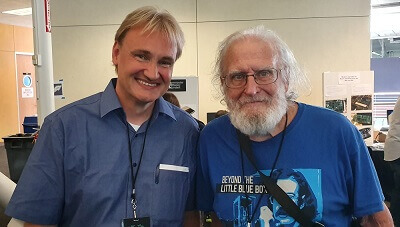 Before Steve Wozniak created the Apple-1, he built, at just 13 years old, a transistor-based calculator and at the age of 19, together with Bill Fernandez, a computer called the Cream Soda Computer. Bill Werner provided the chips for it. Bill Fernandez introduced Steve Jobs to Steve Wozniak.
Before Steve Wozniak created the Apple-1, he built, at just 13 years old, a transistor-based calculator and at the age of 19, together with Bill Fernandez, a computer called the Cream Soda Computer. Bill Werner provided the chips for it. Bill Fernandez introduced Steve Jobs to Steve Wozniak.
Later, Steve Wozniak and Steve Jobs together sold illegal phone phreaking boxes, called Blue Boxes. These were invented by John Draper (aka Captain Crunch). Steve Wozniak (aka Crazy Pollack) met him and started to build his own Blue Boxes. Wozniak even tried to use the Blue Box to prank the pope. He called the pope claiming Henry Kissinger would speak.
According to Steve Wozniak's autobiography "iWoz", he sold his HP 65 calculator for US$ 500 to buy the Apple-1 mainboards. And Steve Jobs sold his VW bus for US$ 750. They needed US$ 1,000 to get a computer company to print the boards. Reference iWoz, Chapter 12, page 173:
"To come up with the $1,000 we thought we’d need … I sold my HP 65 calculator for $500. The guy who bought it only paid me half though, and never paid me the rest. I didn’t feel too bad because I knew HP’s next-generation calculator, the HP 67, was coming out in a month and would cost me only $370 with the employee discount.
And Steve sold his VW van for another few hundred dollars. He figured he could ride around on his bicycle if he had to. That was it. We were in business".
More about this HP 65 and Steve Jobs' VW bus here.
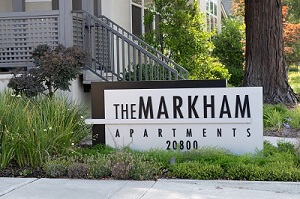 Steve Wozniak designed the Apple-1. Only 200 Apple-1 units were produced in total. According to Steve Wozniak, 175 were originally assembled.
Steve Wozniak designed the Apple-1. Only 200 Apple-1 units were produced in total. According to Steve Wozniak, 175 were originally assembled.
Steve Wozniak wrote in an email that a few were made in a pre-production run. This is evident from the pictures of Apple-1 #2 listed in the registry — clearly a pre-series model of the Apple-1. None of the pre-production Apple-1 units have been seen for many years.
Despite many articles claiming the Apple-1 was designed in a garage, it was actually created in Steve Wozniak's apartments.
Sometimes a unit number appears in articles, but mostly they are incorrect. Articles claimed it was 16K, 36K, etc.
He moved from his apartment 16D to an upstairs apartment. His first apartment was 16D. The number appears in a letter from his "blue box time" as the sender. His nickname was The Crazy Pollack (dial-a-joke).
The Apple-1 was partly built in 16D and finished in his second apartment in another block. Woz stated he couldn’t remember the unit number but guessed it was 22L or 24L.
In a Homebrew Computer Club newsletter (issue number one from March 15, 1975), Woz's apartment is listed as 36K. But at least in 2019, no apartment with this number existed. Strangely, that was from early 1975.
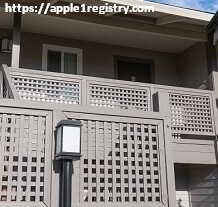
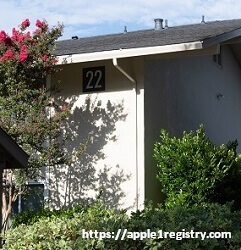 Apple-1 Registry curator Achim Baqué checked it himself and drove to 20800 Homestead Rd in Cupertino in August 2019. It has since been renamed. In blocks 16 and 36, there is no apartment “K”. Block 24 has neither “K” nor “L”. But block 22 has a unit “L”, and it is upstairs (which matches Woz’s information). So maybe, it was 22L.
Apple-1 Registry curator Achim Baqué checked it himself and drove to 20800 Homestead Rd in Cupertino in August 2019. It has since been renamed. In blocks 16 and 36, there is no apartment “K”. Block 24 has neither “K” nor “L”. But block 22 has a unit “L”, and it is upstairs (which matches Woz’s information). So maybe, it was 22L.
Why is this interesting at all? Because it's significant to IT history — it was the foundation stone of Apple.
The unusual display section is a result of the so-called 'Computer Converser', which Steve Wozniak and Alex Kamradt designed as a terminal. The idea came from an article in the magazine *Popular Electronics*, 1975.
The motherboard was designed by Howard Cantin (an Atari employee at the time). Steve Jobs bought the components from Cramer Electronics (now Arrow Electronics) on net 30-day terms. All Apple-1 components, including IC sockets, were soldered in a factory.
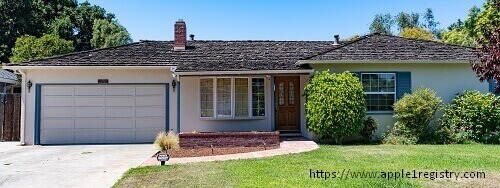 The IC chips were placed in Steve Jobs' parents' house. Steve Jobs' sister and Daniel Kottke equipped the mainboards. His sister assembled just a few before Daniel took over — she bent too many chip pins while watching TV. The first 50 boards were done in the house, the next 50 in the garage. Steve Wozniak showed up about once a week and corrected any mistakes in the garage. As soon as a few mainboards were ready, they were delivered to the Byte Shop.
The initial price of the Apple Computer was US$ 666.66 — simply because Wozniak liked repeating numbers.
The IC chips were placed in Steve Jobs' parents' house. Steve Jobs' sister and Daniel Kottke equipped the mainboards. His sister assembled just a few before Daniel took over — she bent too many chip pins while watching TV. The first 50 boards were done in the house, the next 50 in the garage. Steve Wozniak showed up about once a week and corrected any mistakes in the garage. As soon as a few mainboards were ready, they were delivered to the Byte Shop.
The initial price of the Apple Computer was US$ 666.66 — simply because Wozniak liked repeating numbers.
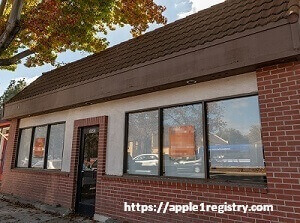 The first 50 Apple-1 units were sold to the Byte Shop, owned by
Paul Terrell, who met Steve at the Homebrew Computer Club. Without this contact, the Apple company might not exist. The Byte Shop was one of the first personal computer retailers. Paul Terrell was a visionary and wanted to offer a fully assembled computer for little money. Only later did he realize that a "complete" computer in Steve Jobs' eyes meant just the assembled board. The keyboard, cassette interface, and tape recorder had to be bought separately.
The first 50 Apple-1 units were sold to the Byte Shop, owned by
Paul Terrell, who met Steve at the Homebrew Computer Club. Without this contact, the Apple company might not exist. The Byte Shop was one of the first personal computer retailers. Paul Terrell was a visionary and wanted to offer a fully assembled computer for little money. Only later did he realize that a "complete" computer in Steve Jobs' eyes meant just the assembled board. The keyboard, cassette interface, and tape recorder had to be bought separately.
East Coast: Later, Stan Veit bought an Apple-1. He was the owner of the East Coast's first computer store. He showcased the computer at the Association of Computer Machinery, and in the beginning, nobody believed that the Apple-1 was truly a computer.
According to Daniel Kottke, a car dealer contacted Apple and wanted to use Apple-1 computers for his business. This could have been the most lucrative idea — but it never happened.
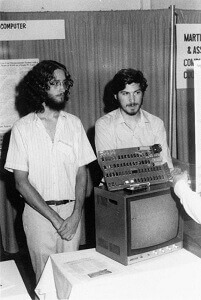
All Apple-1 units came without a case, keyboard, or power supply.
More....
For the first time, the Apple-1 computer was presented on August 28–29, 1976 at the PC76 — Personal Computing Consumer Trade Fair in Atlantic City, NJ, USA (black and white picture).
By the way, it was the first national personal computer show. Steve Wozniak, Steve Jobs, and Daniel Kottke presented the Apple-1 at Stan Veit’s booth.
Woz created the first Apple II in 1976 as well. According to Daniel Kottke, he had the Apple II prototype in a shoebox — already capable of displaying color. He took it to the First West Coast Computer Faire. Apple had booths 326 and 427, perfectly located in front of the entrance.
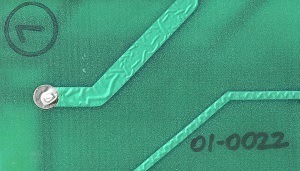 There is no serial number on every Apple-1 computer!
There is no serial number on every Apple-1 computer!
Some (not all!) Apple-1 computers from the 1st batch have a handwritten number on the back, which is obviously a serial number. None of the 2nd batch units have a serial number.
List of all known serial numbers on the back of some 1st batch Apple-1.
There were many theories surrounding these numbers. Only Apple-1 computers sold by the Byte Shop seem to have this number. But nobody remembers where the number really came from. Steve Wozniak, Steve Jobs, Daniel Kottke,
Paul Terrell, the board manufacturer, etc., all say they didn’t put the number on the mainboard.
For a factory, it would be very unusual to write a serial number with a permanent marker on a PCB. Usually, it would be printed on the board or a label would be used.
In January 2022, Achim Baqué found proof that Steve Jobs wrote the serial numbers! Read more here.
Here is a list of all known serial numbers on the back of some 1st batch Apple-1.
In addition to the serial number, some Apple-1 computers have a small round stamp with a number
in the middle. Others have small labels on the back. The origin of these marks is also unknown. Such labels
are usually used in factories.
The Byte Shop theory seems plausible. Only one question remains: why do numbers greater than 50 exist? Mike
Willegal found an explanation. Data Domain Computer had purchased Apple-1 computers directly from the Byte Shop.
Mike asked Thom Hogan (Data Domain Computer) about this. At that time, Data Domain Computers had found a practical
application. One was at the Kentucky Derby.
Ray Borrill, the owner of Data Domain, bought 15 Apple-1s. Probably more later. They sold 13 Apple-1s, 1 was donated to the US Olympic tennis team and destroyed in a plane crash. The last one was auctioned in 2001.
The sale of Apple-1 computers to Data Domain Computers by the Byte Shop explains the higher numbers quite well.
There are computers whose serial numbers are greater than 50.
This is not a contradiction. The Byte Shop received more than just the first 50 and sold some Apple-1 computers to Data Domain Computers.
Some Apple-1 units have a label and/or stamp on the back or front.
Nobody knows the origin, but usually such marks are used for quality control during manufacturing.
Stamps are mostly found on the back under the power section or on the front next to the heat sink.
Labels are found somewhere on the back or sometimes on the breadboard area. So far, the number has two or four digits. Some boards even have two labels. The 4-digit number has so far always been 4062.
The handwritten serial number is always unique, except for one number that exists twice (so far).
Labels with the same number '4062' are found on some boards of the 2nd batch. So far, only Apple-1 units of the 2nd batch have sometimes had labels.
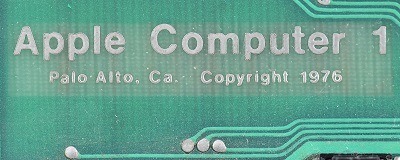 The Apple-1 was produced in two batches: The second batch was made by another manufacturer. Apple-1 units of the first batch were built around April 1976.
These Apple-1 computers are the first ones ever produced and the oldest known. Only the prototypes predate them. And only Apple-1 units of the first batch often have the handwritten serial number on the back.
Because they are several months older, many collectors try to acquire these boards.
The Apple-1 was produced in two batches: The second batch was made by another manufacturer. Apple-1 units of the first batch were built around April 1976.
These Apple-1 computers are the first ones ever produced and the oldest known. Only the prototypes predate them. And only Apple-1 units of the first batch often have the handwritten serial number on the back.
Because they are several months older, many collectors try to acquire these boards.
For example, Mike Willegal created a replica Apple-1 mainboard using the early version of the first batch as a reference.
The mainboards are almost identical, but the color of the mainboard differs.
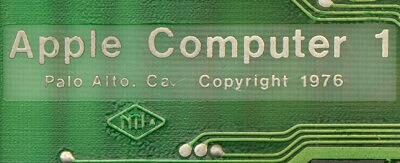 The differences between both versions are easy to spot. The second batch has a rhombic logo with the letters NTI inside, located under the 'Apple Computer 1' logo, and was produced in the second half of 1976.
Decoupling capacitors are square-shaped multilayer capacitors (usually green). Mainboards of the 1st batch have round ceramic capacitors.
Some NTI boards have different electrolytic capacitors. Usually, they are blue, but some NTI boards have one or more yellow electrolytic capacitors.
The PIA and CPU on 1st batch boards are sometimes ceramic chips — usually the CPU. Many 1st batch boards have the plastic AMI PIA.
On the second batch, only plastic chips were used, but some owners later replaced them with ceramic versions for appearance.
The differences between both versions are easy to spot. The second batch has a rhombic logo with the letters NTI inside, located under the 'Apple Computer 1' logo, and was produced in the second half of 1976.
Decoupling capacitors are square-shaped multilayer capacitors (usually green). Mainboards of the 1st batch have round ceramic capacitors.
Some NTI boards have different electrolytic capacitors. Usually, they are blue, but some NTI boards have one or more yellow electrolytic capacitors.
The PIA and CPU on 1st batch boards are sometimes ceramic chips — usually the CPU. Many 1st batch boards have the plastic AMI PIA.
On the second batch, only plastic chips were used, but some owners later replaced them with ceramic versions for appearance.
So far, Apple-1 computers from both the 1st and 2nd batches have achieved very high auction results in the past.
Production prototype – 'Apple Computer A'
 The number of pre-production and hand-wired Apple-1 units is unknown. Unfortunately, it is possible that no such Apple-1 has survived.
The number of pre-production and hand-wired Apple-1 units is unknown. Unfortunately, it is possible that no such Apple-1 has survived.
The pictures show a pre-production Apple-1. By far the biggest difference is the name: the motherboard reads "Apple Computer A © 76".
More about it here.
The Apple Cassette Interface

 The Apple Cassette Interface exists, like the Apple-1 itself, in two versions: 1st batch and 2nd batch (marked “NTI”).
Sometimes NTI Apple Cassette Interfaces are used for 1st batch Apple-1s, simply because the owner bought them later. In the beginning, no Apple Cassette Interface was available.
The Apple Cassette Interface exists, like the Apple-1 itself, in two versions: 1st batch and 2nd batch (marked “NTI”).
Sometimes NTI Apple Cassette Interfaces are used for 1st batch Apple-1s, simply because the owner bought them later. In the beginning, no Apple Cassette Interface was available.
Some Apple-1 units were traded in for credit on the Apple II. The credit offered was not a great deal. For example, see the letter from Fred Hatfield—he turned it down.
The only person I've come across who actually did a trade-in was Bob Bishop, a famous Apple II programmer. I exchanged some emails with Bob recently, and he doesn't remember what he received. He thinks it was similar to what Fred was offered.
A couple of units probably resulted from such trade-ins. These are the two that the Huston brothers took from the pile in Steve Jobs’ office. Although there are stories of many Apple-1s being traded in for Apple IIs, I found evidence of very few actual trade-ins.
Early in Apple’s history, there was a stack of Apple-1s initially stored in a cabinet in the lab, later moved to Steve Jobs' office.
Depending on which early Apple employee you ask, the stack was either large or small. The best take is that there was a modest number of individual units, but they took up a large vertical space due to the height of the heat sink.
There were two categories in this stack. In addition to a few units traded in for Apple II credit, there were unsold Apple-1s never populated with chips or tested.
A number of early Apple employees were allowed to take one of these boards home. All of the unsold units were NTI boards with empty sockets. Some have since been populated and brought to life.
Since few know the story of the unpopulated/unsold boards, people encountering them usually speculate that the chips were removed after being sold.
Most likely, many Apple-1s were trashed. There are rumors about a fire in Steve Wozniak’s garage—maybe his prototype(s) were destroyed.
Known destroyed Apple-1s:
1. One Apple-1 donated to the US Olympic tennis team was reportedly destroyed in a plane crash. Remarks from Achim Baqué: This information comes from Ray Borrill. No information about this crash could be found. ESPN lists athletes killed in plane crashes, but no relevant Olympic members or tennis players were identified.
2. One former Apple-1 owner said his father broke the Apple-1 mainboard in two and threw it away.
3. Someone in Germany got original chips from an Apple-1. This Apple-1 was likely bought in the US cheaply and later destroyed.
4. Another story from a guy named Kevin:
In the late 1990s, I worked with a gentleman named Robert Fischer who previously worked for Sierra Online. Apparently, they acquired an Apple-1 to investigate writing software for it but soon discovered its limitations and the very limited number that existed, even then. As it was told to me, he remembers being told to dispose of it, so he put it—along with all accessories and documentation—in the dumpster. It was gone. Even back then, he regretted the action, but what could he do?
Rumor / possible marketing trick:
The story of an almost-destroyed Apple-1 found in a recycling center is a bit strange. There’s no proof it's true. No picture of the Apple-1 has been published, yet the company was in the news for a long time. After gaining so much attention, many people sent old computers to them. Numerous requests for a photo or info went unanswered. No Apple-1 expert or collector was ever contacted by the recycling company.
Even the Apple Company used different names in ads and price lists. On the mainboard, it's Apple Computer 1. In price lists, it's Apple I. There is no strictly correct name.
In early ads and the manual, however, it's Apple-1. Steve Wozniak preferred this version. That’s reason enough for me to use Apple-1.
Some people argue it should be Apple II. Well, the correct version is Apple ][. Even the third model was Apple III. The names always had a creative touch.
Apple-1 mainboards are wave soldered. Exceptions include prototypes and a single 1st batch Apple-1.
Wave soldering is effective and inexpensive but has downsides. Adhesion between tracks and board can loosen. So far, this has not been a problem for any Apple-1.
On many Apple-1 boards, you’ll see wrinkled protective coating on the back. It looks like a ripple effect. There’s no excess solder underneath—just the high-temperature wave soldering process. It’s normal.
Often, some coating parts detach. This typical peeling is caused by wave soldering and the board's age. Some lost more coating over time, but it's only a cosmetic issue.
 The Apple-1 has a so-called breadboard, used to add electronic parts. Steve Wozniak included the breadboard to let users modify or enhance the computer.
Electronic parts were connected via wires to other ICs and traces on the mainboard.
The Apple-1 has a so-called breadboard, used to add electronic parts. Steve Wozniak included the breadboard to let users modify or enhance the computer.
Electronic parts were connected via wires to other ICs and traces on the mainboard.
Many early Apple-1 owners used it. In auctions during the 2000s, those added electronics were often removed.
The processor.
The Apple-1 uses the 6502 CPU, mostly MOS 6502.
Some CPUs are in ceramic housings—mostly white ceramic. Others are in plastic housings.
Originally, Steve Wozniak planned to use the Motorola 6800. The 8080 was too expensive. Even the 6800 was pricey, though he liked it due to its use in his favorite minicomputers.
His friend Allen Baum discovered the 6502 at a MOS Technology booth and told Steve. As soon as Woz got one at the Homebrew Computer Club, he switched plans. The 6502 was just $25—extremely cheap in 1976. Sometimes it’s white or purple ceramic, sometimes plastic. Made by MOS.
Used as an interface for keyboard and display. Sometimes this chip is white or purple ceramic, sometimes plastic.
The PIA has the number 6520; Motorola used 6820. Later, the 6521 was used as a substitute.
PIAs from AMI, Synertek, or Motorola were used in the Apple-1. AMI was widely used in the 1st batch.
The memory of the computer.
Memory came in ceramic and plastic housings. Plastic was more common.
DRAM was a major step forward. Many computers used SRAM, which was more expensive. Each chip holds 4096x1 bits = 512 bytes. In an Apple-1, 8 are used for one row = 4 KBytes.
Apple-1s used 4 or 8 KBytes. With some modifications, more memory is possible. But that requires adding wires and electronic parts manually—only for experienced users. According to Apple ads, even 64 KBytes are possible.
 The firmware of the Apple-1 is stored in two 256x4-bit PROMs.
The firmware of the Apple-1 is stored in two 256x4-bit PROMs.
The Woz (Steve Wozniak) monitor program fits in just 256 bytes. It allows keyboard input of commands and machine code for the 6502. PROM is a non-volatile type of Read-Only Memory.
There was no built-in reset circuit. You needed an extra switch to reset the computer manually.
Original and unmodified Apple-1s can only use uppercase characters.
Everything was squeezed into this tiny memory—254 out of 256 bytes were used. Great job!
Fairchild - Fairchild Semiconductor
Most ICs in 1st batch Apple-1s were made by Fairchild Semiconductor, based in San Jose, California, USA.
Signetics
Most ICs in 2nd batch Apple-1s (and some in the 1st) were made by Signetics, based in Sunnyvale, California, USA.
MOS - MOS Technology, Inc.
Maker of the 6502 CPU and 6520 PIA. Most Apple-1s use MOS 6502.
AMI - AMI Semiconductor
Made the 6502 CPU and PIA 6820. AMI PIA was used in 1st batch Apple-1s.
Synertek
Made both the 6502 CPU and the PIA 6520.
Motorola
Produced the PIA 6820.
Mostek
DRAM MK4096N-11 used in Apple-1 was made by Mostek. Sometimes DRAM MK4096P-11 was used (as seen in the article 'Comparing Apples and Oranges,' the Interface July 1976 ad, and Sunshine Computer’s ad in Interface Age).
The difference lies in the package. N = Epoxy DIP (Plastic), P = Gold side-brazed ceramic DIP, J = CER-DIP, K = Tin side-brazed DIP. -11 is the speed (350ns access time, 500ns cycle time). Apple used only -11.
Other variants like -6 and -16 have different timing and were added later.
Sprague
Produced the large capacitors used in the Apple-1.
We appreciate your help:
Please spread the word about the Apple-1 Registry by adding a link to your social media account and/or website.
Contact us if you have new information about any Apple-1 or Apple-1 (parts) for sale.
You may link to the Apple-1 Registry. Any form of reprint or reproduction (including excerpts) is only permitted with written permission from the Apple-1 Registry.
Here you will find press releases and images free to use under CC BY-SA 4.0.